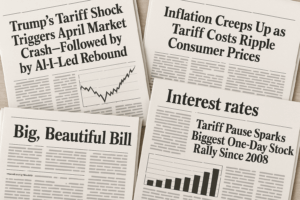
The Election and the Market – Congressional
News & CommentaryBy: Jude McDonough, CFP® AIF®
Aug 13, 2020
On Monday, we showed you how the market performed after different Presidential Election outcomes. Today, we are going to provide you with data on different Congressional Election outcomes. While I usually do webcasts on Wednesdays and was planning on making this post next Monday, our readers seemed a lot more interested in this than a webcast so I listened.
Congressional Elections happen every two years so the data is slightly more difficult to compile. We are going to use the same two sources we used on Monday to give you different data points. Fidelity gave us data all the way back to 1789 and showed both 2- and 4-year performance since Congress could change at the Mid Term Election. It is worth noting that divided congress in this data simply meant that the president, house and senate were not all controlled by the same party. The table below shows the results:
| Outcome | Average Annualized Return (2 Years) | Average Annualized Return (4 Years) |
| Democratic Sweep | 3.4% | 8.2% |
| Republican Sweep | 12.2% | 8.6% |
| Republican President/Divided Congress | 1.1% | 8.7% |
| Democratic President/Divided Congress | 14.5% | 10.9% |
Our other source went back to 1928 and was a little bit simpler as it did not separate by party. It showed 3-month, 6-month, 1-year and 2-year cumulative returns following every election with the averages of those numbers. We’ll share the averages below:
| Outcome | Cumulative Return (3 Months) | Cumulative Return (6 Months) | Cumulative Return (1 Year) | Cumulative Return (2 Years) |
| Divided Congress | 1.6% | 4.3% | 1.3% | 5.7% |
| Unified Congress/Different White House | 6.8% | 11.5% | 11.9% | 16.1% |
| Unified Congress and White House | 2.6% | 5.6% | 9.8% | 17.6% |
So what does all of this data mean? Well, I don’t know about you, but the thing that stood out to me most was that the averages were positive in every outcome. Just so we’re clear, I’m not guaranteeing that or promising positive returns after the election. I’m simply interpreting the data. What I will say is that the election might not matter as much as you think. Sure, there are a lot of factors. Biden can completely change Trump’s tax plan and increase regulation that Trump took away. If you are on Trump’s side, these are probably major reasons why you’re nervous about a Biden presidency. If you’re on the Biden side, you can’t fathom another 4 years of Trump.
Regardless of where you stand, you can’t argue with the numbers. There were times in history where the market did fine when your side didn’t win whether you’re a Democrat or a Republican. This happens every 4 years. People think that a loss for their side is going to be bad for the market. You know what happens every four years? The election comes and goes. Administrations change. Policies change. The news changes. Some people are happy with the outcome and others are upset with it. Life goes on.
As a long-term investor, the Trump administration won’t be the last one your portfolio lives through. Neither will Biden’s if he wins. The election is a short-term event that will be over in a couple of months. Instead of getting hung up on the event and trying to time the market, you should take the time to understand how much risk is in your portfolio and make sure that you constructed a portfolio that fits into your financial plans. Furthermore, while it may feel boring, the diversified, long term approach should prevail in the long run.
*Source: Fidelity Investments; monthly data since 1789 (a mix of S&P 500, Dow Jones Industrial Average, and Cowles Commission indexes). Past performance is no guarantee of future results. Indexes are unmanaged. It is not possible to invest directly in an index.
**Investech Research Newsletter – July 17, 2020


